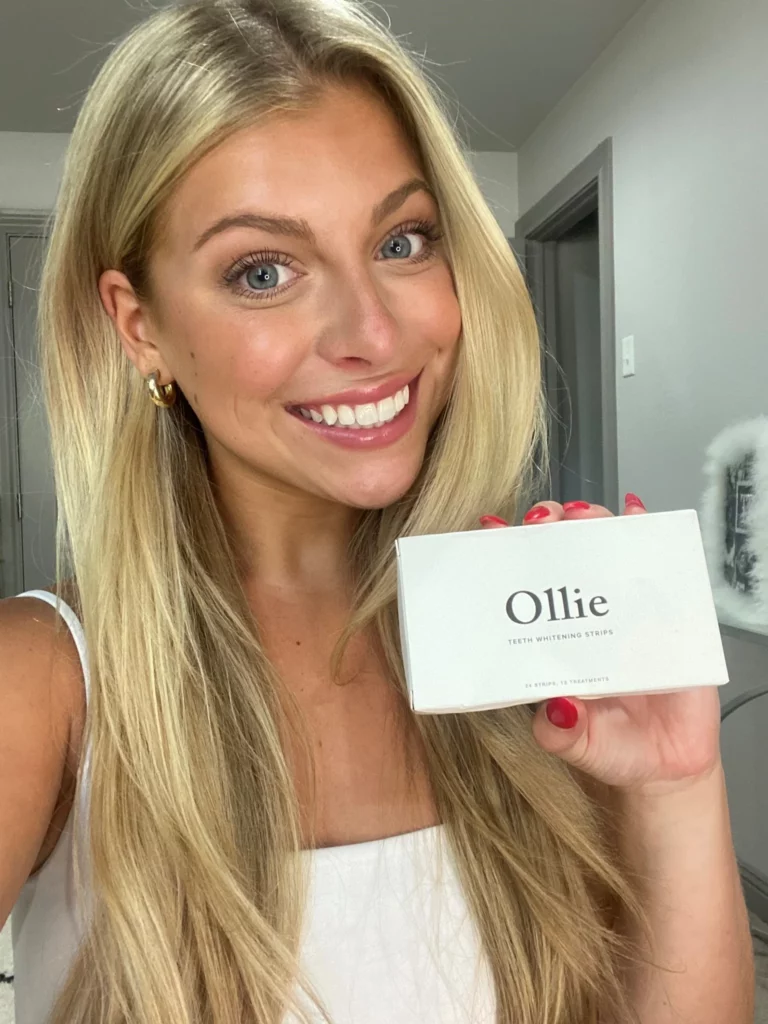Are you looking to achieve a bright and dazzling smile? Crest White Strips can be your go-to solution for achieving those pearly whites. These whitening strips have gained immense popularity due to their effectiveness in removing stains and giving your teeth a noticeable shine. In this article, we will guide you step by step on how to use Crest White Strips effectively and address common concerns and questions along the way.
How To Use Crest White Strips Step By Step
Using Crest White Strips is a simple process that can be incorporated into your daily routine. Follow these steps for optimal results:
- Do NOT brush your teeth prior to starting treatment
- Begin by opening the packaging and taking out both the upper and lower strips.
- If necessary, customize the strips to fit the height of your teeth. You can do this by carefully cutting each strip to the appropriate size.
- Once you have prepared the strips, peel off the plastic covering that protects the adhesive layer on the side that will come into contact with your teeth.
- Before placing the strips, make sure your teeth are totally dry. You can do this with a soft cloth. If you have a lot of saliva on your teeth, then it might be difficult to get the strips to stick properly.
- Take caution while placing the strips on your teeth. Ensure that the gel side of the strip sticks onto your teeth while avoiding contact with your gum line. Position them accurately for maximum coverage and effectiveness.
- Consult the instructions provided on the packaging to determine the recommended duration for leaving the strips on your teeth. After the designated time has elapsed, carefully remove the whitening strips from your teeth. Make sure to peel them off gently to avoid causing any discomfort or damage.
- Rinse your mouth thoroughly with water to remove any residual gel or debris from the whitening strips. Take your time to ensure your mouth feels clean and refreshed.
It is advisable to wait at least two hours before brushing your teeth after the whitening treatment. This allows the active ingredients in the Crest Whitestrips to continue working effectively.
Additionally, refrain from eating for at least one hour after removing the strips. This gives your teeth time to recover from the treatment and reduces the likelihood of staining.
If desired, you can repeat the treatment following the same steps outlined above. However, it is crucial to adhere to the guidelines provided on the packaging and avoid exceeding the recommended number of consecutive days. Generally, the recommended duration for using Crest Whitestrips ranges from 10 to 20 consecutive days for optimal results.
How Often Can You Use Crest Whitestrips?
The frequency of using Crest White Strips depends on the specific product you choose. While some variations are designed for daily use, others may require less frequent application. Always refer to the instructions provided with your Crest White Strips to ensure you are using them as directed. Overuse of whitening products can lead to tooth sensitivity or other undesirable effects, so it’s important to follow the recommended guidelines.
Do you brush your teeth after Crest whitening strips?
Yes, it is advisable to brush your teeth after using Crest White Strips. Brushing helps remove any remaining residue from the strips and leaves your mouth feeling fresh. Use a gentle toothbrush and fluoride toothpaste to maintain your oral hygiene routine.
How long do you put Crest White Strips on for?
Crest White Strips are typically worn for around 30 minutes per application. However, it is crucial to read the specific instructions provided with the product you are using, as different variations may have slightly different recommended durations. Avoid leaving the strips on for longer than instructed, as this can increase the risk of tooth sensitivity and other potential side effects.
What happens if you leave whitening strips on longer than 30 minutes?
Leaving whitening strips on longer than the recommended duration can have adverse effects on your teeth and gums. Prolonged exposure to the whitening agents in the strips can lead to increased tooth sensitivity and potential gum irritation. To prevent these issues, always follow the instructions and remove the strips within the specified time frame.
What are the side effects of Crest Whitestrips?
While Crest White Strips are generally safe to use, some individuals may experience mild side effects. These can include tooth sensitivity, gum irritation, or temporary white spots on the teeth. These side effects are typically temporary and subside after the whitening treatment is complete. If you experience persistent discomfort or adverse reactions, it is advisable to discontinue use and consult your dentist.
What not to do after using Crest whitening strips?
After using Crest White Strips, it is important to avoid certain habits or substances that may interfere with the whitening process. Here are a few things to avoid:
Staining foods and beverages
For the best results, try to avoid consuming staining foods and beverages such as coffee, tea, red wine, or colored sauces immediately after using Crest White Strips. These substances can diminish the effectiveness of the whitening treatment.
Smoking
Smoking not only stains your teeth but also hinders the whitening process. It is best to refrain from smoking or using tobacco products to maintain the results of your whitening treatment.
Acidic drinks
Acidic drinks like citrus juices and sodas can temporarily soften the tooth enamel, making it more susceptible to staining. Avoid consuming these beverages immediately after using Crest White Strips.
Intense brushing
While brushing your teeth is essential for oral hygiene, avoid aggressive or intense brushing immediately after using Crest White Strips. This can potentially cause gum irritation or sensitivity.
Can you drink water with whitening strips on?
It is generally recommended to avoid drinking water while wearing Crest White Strips. The strips adhere better to dry teeth, and water can dilute the whitening agent’s effectiveness. However, if you need to drink water, do so sparingly and try to avoid swishing it around your mouth. Remember to remove the strips before consuming any other liquids or foods.
Crest Whitening Strips Ingredients
Crest White Strips contain several key ingredients that contribute to their whitening effects. The primary active ingredient is hydrogen peroxide, a well-known tooth whitening agent. Other ingredients may include water, glycerin, carbomer, sodium hydroxide, and various flavoring agents to enhance the overall experience. Always check the packaging or product information for a detailed list of ingredients, especially if you have any known allergies or sensitivities.
Best Alternatives for People with Sensitive Teeth
While Crest White Strips are a great solution, the biggest complaint people have is they cause tooth sensitivity.
Luckily there are new teeth whitening strips on the market that contain potassium nitrate Like Ollie teeth whitening strips. Potassium nitrate is the same compound used by dentists during professional teeth whitening treatments to reduce tooth sensitivity, so it definitely works.
So if you love the idea of teeth whitening strips, but suffer from sensitivity issues, give Ollie teeth whitening strips a try!. If you prefer to stick to Crest Whitening strips and suffer from sensitivity you can use Sensodyne Pronamel toothpaste which also contains 5% potassium nitrate to reduce sensitivity.

Check Pricing For Ollie Teeth Whitening Strips
Conclusion
Crest White Strips offer a convenient and effective solution for achieving a whiter smile in the comfort of your own home. By following the step-by-step instructions, being mindful of frequency and duration, and taking care of your oral hygiene, you can maximize the results of using Crest White Strips. Remember to be patient, as it may take several applications to achieve your desired level of whitening. Embrace the journey to a brighter smile, and enjoy the confidence that comes with it.
Related Articles
How Much Does Teeth Whitening Cost? The Complete Guide
Baking Soda Toothpaste: Does it really work?
Fatima Khan is a healthcare professional. She has contributed to the healthcare industry as a nurse, nutritionist, adjunct professor, and Dentist. She holds a Master's degree in Biomedical Science and Doctorate in Dental Medicine and is currently practicing Dentistry in Houston, TX. She is the co-founder of Riven oral care, a probiotic-based mouthwash that helps you strengthen your oral microbiome.
Marcus Ramsey has been a professional writer for over seven years. He has talked about and produced content for industries like Dentistry, Healthcare, and more.






